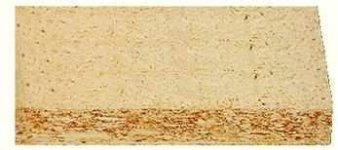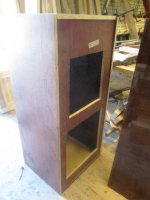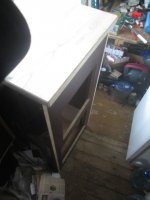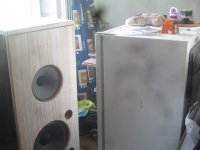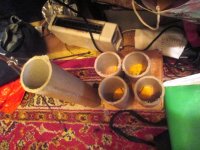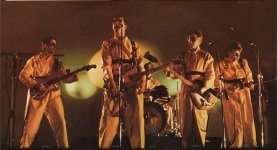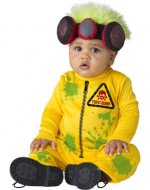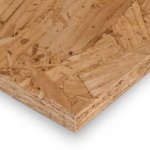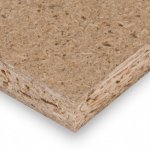MDF is a carcinogen. The dust is very dangerous! Use ply wood everytime.
All wood dust has been associated thusly, but, yes, MDF dust is pretty nasty. Unfortunately, anything coming off a table saw or sanding is extremely fine and wont to get deep into your lungs, so I would strongly recommend that everyone treat all their woodworking as if they were working with MDF.
I realize this is a near-religious talk (being polite), but one could make an excellent speaker case out of OSB truth be told(and I have): as said above, the design of the cabinet outweighs the material. Anyone who pays the smallest amount to structural design learns that, especially because we hardly care about strength as we exceed our need by a mile achieving a desired stiffness and damping. Exception is going thinner with high quality ply for pro-sound.
Plywood has more sustain than MDF which is not good for speaker cabinets (but a very good feature for musical instruments). The better cabinet would be a combination of two types of material. For guitar cabs plywood has the better tone (lively) compared to MDF or PB.
MDF boxes can be very dead if designed properly, I`ve yet to hear a very dead box made out of standard thickness plywood. Plywood has some advantages and disadvantages:
Pluses
- durable
- lighter than MDF if you want to carry arround
- might add some organic feeling to the sound (my observation, subjective of course)
Minuses
- very prone to chirping which makes finishing much harder - I use high quality Freud tungsten carbide router bits and plywood chips a lot, especially at the bottom of cutouts. One way to solve is to add paper tape which keeps it somewhat in place
- might colour the sound a bit
- more expensive than MDF
- if you want to pain it, it needs a a lot more preparation
Generally, I would use MDF for about anything related to speakers. Its dust has to be collected as it contains formaldehyde but in Europe it has to abide to the E1 regulation standard which means the formaldehyde content would be at around 1/1000 of the danger zone.
MDF boxes can be very dead if designed properly, I`ve yet to hear a very dead box made out of standard thickness plywood. Plywood has some advantages and disadvantages:
Pluses
- durable
- lighter than MDF if you want to carry arround
- might add some organic feeling to the sound (my observation, subjective of course)
Minuses
- very prone to chirping which makes finishing much harder - I use high quality Freud tungsten carbide router bits and plywood chips a lot, especially at the bottom of cutouts. One way to solve is to add paper tape which keeps it somewhat in place
- might colour the sound a bit
- more expensive than MDF
- if you want to pain it, it needs a a lot more preparation
Generally, I would use MDF for about anything related to speakers. Its dust has to be collected as it contains formaldehyde but in Europe it has to abide to the E1 regulation standard which means the formaldehyde content would be at around 1/1000 of the danger zone.
People can safely work with plutonium if their workshop is set up correctly and they wear the appropriate gear!
When working with MDF, you should have appropriate dust collection, proper ventilation and air filtration, and wear an appropriate personal respirator (a NIOSH-approved dust mask for particulates) when sawing or sanding.
When working with MDF, you should have appropriate dust collection, proper ventilation and air filtration, and wear an appropriate personal respirator (a NIOSH-approved dust mask for particulates) when sawing or sanding.
Plywood has more sustain than MDF which is not good for speaker cabinets
That is questionable. If one pushes the potential resonances high enuff, and of high enuff Q, they will never get excited so it is as if they are not there at all.
dave
Don't forget chipboard.
A sandwich of 12 mm chipboard and two 4 mm sheets of MDF or ply make a 20 mm panel with better properties for speaker enclosures than single sheets of MDF or plywood.
A sandwich of 12 mm chipboard and two 4 mm sheets of MDF or ply make a 20 mm panel with better properties for speaker enclosures than single sheets of MDF or plywood.
My enclosures are made of chipboard, but it is important to choose the correct grade.Don't forget chipboard.
The random orientation and size of the wood chips results in superior vibration absorption properties to those of MDF with it more homogenous structure.Chipboard is available in a number of densities; normal, medium and high-density. Normal density is fairly soft and 'flaky', high-density is very solid and hard (often used for worktops and fire doors) - medium density is somewhere in between.
Attachments
Who is this Snell?
I guess the Baltic birch must be the stuff that grows just down the road from here and just about anywhere there is woodlands..common as anything!
Needs lots of bog land and water & I guess likes cold winters.
When I came to make my cabs I chose to use a support mask in MDF or chipboard whatever it was, from a salvaged soviet cupboard I cut up.
The support mask construction has some big advantages in sound projection, placing the driver out of the direct box area.
I am a great believer in making the front which mounts the drivers absolutely rigid and chamfering the outer edges, so we made that and the top a good 1" thick.
The whole thing must weigh a good 80kg+ as I can't lift it,- no way.
See it's bigger than my huge old freezer
The MDF or whatever they used, was covered in a typical delicious heavy varnished verneer, looking like real wood.
The front and top we made from ASH, it's 1.2m high with 2 HUGE drivers on it, and the ports which were salvaged cardboard tubes I got out of a big plotter from a local printer.
This should give you some ideas, common sense mostly and a brilliant local Baltic workshop.
They did all I asked and bought the right special hole cutter and chamfered the driver holes, just like they should be.

I guess the Baltic birch must be the stuff that grows just down the road from here and just about anywhere there is woodlands..common as anything!
Needs lots of bog land and water & I guess likes cold winters.
When I came to make my cabs I chose to use a support mask in MDF or chipboard whatever it was, from a salvaged soviet cupboard I cut up.
The support mask construction has some big advantages in sound projection, placing the driver out of the direct box area.
I am a great believer in making the front which mounts the drivers absolutely rigid and chamfering the outer edges, so we made that and the top a good 1" thick.
The whole thing must weigh a good 80kg+ as I can't lift it,- no way.
See it's bigger than my huge old freezer
The MDF or whatever they used, was covered in a typical delicious heavy varnished verneer, looking like real wood.
The front and top we made from ASH, it's 1.2m high with 2 HUGE drivers on it, and the ports which were salvaged cardboard tubes I got out of a big plotter from a local printer.
This should give you some ideas, common sense mostly and a brilliant local Baltic workshop.
They did all I asked and bought the right special hole cutter and chamfered the driver holes, just like they should be.

Attachments
Last edited:
I have always found plywood lighter and easier to work with.
I ran a mobile disco for many years so lightness was good carrying speakers upstairs.
I ran a mobile disco for many years so lightness was good carrying speakers upstairs.
I am in agreement with Galu on the chipboard being a remarkably good choice of a material and my personal preference as well. A quote from Stereophile review of Wharfedale Linton Heritage, page 1st.
Comeau has a clear preference in cabinet materials. "Personally, I'm a fan of high-density chipboard for cabinets and pioneered, for Wharfedale, the sandwich of chipboard with MDF skins that we now use. I have a raft of technical research which shows the superiority of chipboard over MDF."
Comeau has a clear preference in cabinet materials. "Personally, I'm a fan of high-density chipboard for cabinets and pioneered, for Wharfedale, the sandwich of chipboard with MDF skins that we now use. I have a raft of technical research which shows the superiority of chipboard over MDF."
People can safely work with plutonium if their workshop is set up correctly and they wear the appropriate gear!
Talk about a reactive speaker! Maybe for high-energy music?
Attachments
Chip board is fine for home or use where it wont be taken outside.I am in agreement with Galu on the chipboard being a remarkably good choice of a material and my personal preference as well.
I made a couple of speakers for a disco out of veneered chip board.
First time after a gig when it was wet and they swelled up badly and fell apart.
Ha! Ha!Talk about a reactive speaker!
So, handling plutonium would be child's play! 😉There's actually no health hazard from touching plutonium. Just wash your hands afterward so that no traces of it get inside you. It presents zero risk outside of the body.
A large piece of plutonium feels warm to the touch because of the energy given off by alpha decay - larger pieces can produce enough heat to boil water.
Attachments
My chipboard disco cabinets were covered in Tolex vinyl.I made a couple of speakers for a disco out of veneered chip board.
First time after a gig when it was wet and they swelled up badly and fell apart.
They had to be totally beer and lager proof!

No, the high-density variety - not the plastic veneered c**p that Ikea use! 😛chipboard, you mean the stuff Ikea used to make everything?
Chipboard = OSB (oriented strand board), not foil covered particle board (everything I've seen from Ikea). I rescued a bunch of 19mm OSB from a shipping crate at work and made an extremely dead MLTL (inherent bracing) subwoofer. Was pretty surprised about it, honestly. Could see skinning it with 1/8" MDF skins to get a good veneer/paint surface (probably want a vacuum press though), but mine was a rough and tumble box. It's also fortuitously cheaper than both plywood and MDF, so definitely something worth using for prototypes!
I'm curious about other engineered wood products like LVL or Parallam (in their various guises), but usually those are made into beams rather than sheet goods.
I'm curious about other engineered wood products like LVL or Parallam (in their various guises), but usually those are made into beams rather than sheet goods.
The difference between OSB and high-density chipboard is described and illustrated within this link:
https://www.trend-uk.com/en/UK/trend/content/content_detail.php?record_type=Knowledge&id=20910
https://www.trend-uk.com/en/UK/trend/content/content_detail.php?record_type=Knowledge&id=20910
Attachments
I think it's a transatlantic terminology issue, I've come across it before, I believe in the USA it's known as a Weetabix
Indeed. Over here, that's particle board on the right, chipboard on the left. But I'm not eatin' either one!
- Home
- Loudspeakers
- Multi-Way
- Is MDF or plywood better for speaker cabinets?
